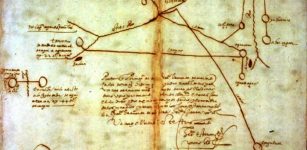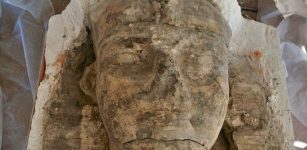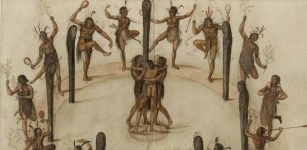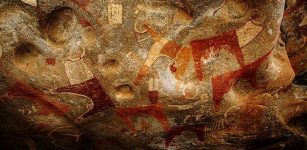Vesta And Her Six Vestal Virgins – Highly Venerated Goddess Of Hearth And Family
A. Sutherland - AncientPages.com - In ancient Roman beliefs, Vesta (the equivalent of the Greeks' Hestia) was the goddess of fire, home, and family.
She was an abstract goddess of the hearth, chastity, and ritual bonfires.
The goddess was rarely depicted in human form, and generally, no myths are associated with her. However, Vesta is one of the most important Roman divinities and probably one of the oldest European deities. She was one of the daughters of Saturn and Ops, a goddess of fertility and earth.
No temple or household began with their ceremonies until Vesta's fire was lit. The cult of Vesta, however, was religious worship that lay deep in our Indo-European past and was grown privately by individual families.
Also, the veneration of fire is an old tradition. Fire has been essential in human life since the dawn of history. The deification of fire is known from various Indo-European cultures. One of the most important deities in the Slavic pantheon was Svarog (Swarog), the god of celestial fire and the guardian of the Slavic home fire and the sacrificial fire. In Vedic India, people worshiped the fire-god Agni (which means: 'fire'), and the ancient Iranian Zoroastrians were famous fire-worshippers. Their concept of holy fire was Atar (fire god).
Officially, Vesta was represented by the sacred, eternal fire in her temple in the Roman Forum ('Forum Romanum'), considered the heart of ancient Rome.
Despite that worship of Vesta, and several other gods, had its roots in the Roman home, with time, it developed into an established cult during the reign of either Romulus or Numa Pompilius.
The latter is believed to have introduced her worship in Rome and constructed the temple in Vesta's honor, initially located on the slope of Palatine Hill. It was not an ordinary temple where gatherings could occur, as in other Roman temples.
 A vestal virgin. Gravy av Frederick Leighton, circa 1890. Public Domain
A vestal virgin. Gravy av Frederick Leighton, circa 1890. Public Domain
An eternal fire, representing Vesta, burned in the temple, and it ceased to exist in 394 AD at the order of the Christian Emperor Theodosius the Great, a Roman Emperor from 379 to 395. Theodosius (who also banned the pagan rituals of the Olympics in ancient Greece) dissolved the Order of the Vestal Virgins in Rome.
Vestals And Their Life After Thirty-Year-Long Service
Her priestesses - Vestals - were the virgins who kept and cared for the sacred fire that symbolized the existence of Rome (the 'eternal city').
According to tradition, six chosen vestals came to serve the goddess. These girls (seven to 10 years old and from good families) had to take a vow of chastity. If the vow was broken and the Vestal was found guilty, she was punished by being walled up in the Campus Sceleris ('Field of Wickedness') and left for her death.
The priestesses were freed of the usual social obligations to marry and bear children. Instead, they devoted themselves to the study and correcting state rituals that were off-limits to the male colleges of priests.
 Vestal virgin hanging an ivy wreath during Vestalia Festival. Carl Friedrich Deckler (1838–1918). Public Domain
Vestal virgin hanging an ivy wreath during Vestalia Festival. Carl Friedrich Deckler (1838–1918). Public Domain
The Vestals played an essential role in ancient Rome's ceremonial life. Besides guarding Vesta's fire, the Vestals often attended festivals, and their duties included making the so-called "salted flour" (mola salsa), a mixture sprinkled over the sacrificial animals. The Vestals served in the temple for thirty years before being replaced by new ones.
After thirty years, the Vestal could give up the priesthood, return to ordinary life and even get married. Few of them, however, used this right. Instead, they preferred to serve the goddess until their death.
Vestals could, with their own hands, without a guarantor, manage their affairs, which for the most part, were not allowed to other Roman women.
The Vestals in the service enjoyed great privileges and honors as a reward for their long and dedicated service. The consul himself at the meeting gave way to the vestals.
 Statues of the Vestal Virgins - in front of the Atrium Vestae. Image Credit: Carole Raddato - CC BY-SA 2.0
Statues of the Vestal Virgins - in front of the Atrium Vestae. Image Credit: Carole Raddato - CC BY-SA 2.0
Vestalia Festival That Honored The Goddess And Her Priestesses
Vesta was highly respected as the one who watched over the hearth, which provided light and warmth, nourishment, and protection to the family. In this way, she was a guardian of the Roman people, and as much as they divinized the hearth, they also honored Vesta's existence by organizing the Vestalia. It was one of the most celebrated Roman holidays from the 7th to the 15th of June each year.
During this holiday, married women made offerings in the form of food in Vesta's temple. It was also a festival of bakers; Vesta's priestesses baked special bread made of salted flour, and the mills were decorated with wreaths and flowers.
Written by – A. Sutherland - AncientPages.com Senior Staff Writer
Updated on March 30, 2024
Copyright © AncientPages.com All rights reserved. This material may not be published, broadcast, rewritten or redistributed in whole or part without the express written permission of AncientPages.com
Expand for referencesReferences:
Benjamin W. Fortson, IV, Indo-European Language, and Culture: An Introduction
Mary Beard M. North J. Religions of Rome: Volume 1
More From Ancient Pages
-
 Llangernyw Yew: Chilling Prophecy Of The Oldest Tree In Wales
Featured Stories | Oct 28, 2022
Llangernyw Yew: Chilling Prophecy Of The Oldest Tree In Wales
Featured Stories | Oct 28, 2022 -
 Mysterious Greyfriars Kirkyard: A Cemetery In Edinburgh With Dark And Spooky History
Featured Stories | Sep 16, 2016
Mysterious Greyfriars Kirkyard: A Cemetery In Edinburgh With Dark And Spooky History
Featured Stories | Sep 16, 2016 -
 Jure Grando – First ‘Real’ Historical Vampire Case Documented
Featured Stories | Jun 16, 2021
Jure Grando – First ‘Real’ Historical Vampire Case Documented
Featured Stories | Jun 16, 2021 -
 Anglo-Saxons Practically Eradicated Native Britons: The Question Is: Was It Ethnic Cleansing?
Archaeology | Jan 8, 2019
Anglo-Saxons Practically Eradicated Native Britons: The Question Is: Was It Ethnic Cleansing?
Archaeology | Jan 8, 2019 -
 Ancient Mystery Of Leti – A Homo Naledi Child Of Darkness Discovered In The Rising Star Cave System
Archaeology | Nov 6, 2021
Ancient Mystery Of Leti – A Homo Naledi Child Of Darkness Discovered In The Rising Star Cave System
Archaeology | Nov 6, 2021 -
 Rare Well-Preserved 2,500-Year-Old Dagger Linked To The Keeladi Civilization Discovered In Tamil Nadu, India
Archaeology | Aug 13, 2021
Rare Well-Preserved 2,500-Year-Old Dagger Linked To The Keeladi Civilization Discovered In Tamil Nadu, India
Archaeology | Aug 13, 2021 -
 Thousand-Year-Old Sarcophagus Discovered In Odense
News | Sep 28, 2015
Thousand-Year-Old Sarcophagus Discovered In Odense
News | Sep 28, 2015 -
 Rare 2000-Year-Old Celtic Figurine Among Finds In Cambridgeshire
Archaeology | Dec 18, 2018
Rare 2000-Year-Old Celtic Figurine Among Finds In Cambridgeshire
Archaeology | Dec 18, 2018 -
 Etzanoa: Long-Lost Native American City Discovered In Kansas After 400 Years
Archaeology | Apr 24, 2017
Etzanoa: Long-Lost Native American City Discovered In Kansas After 400 Years
Archaeology | Apr 24, 2017 -
 Fomorians In Irish Myths And Legends: Race Of Demonic Giants Who Inhabited Ireland And Scotland
Celtic Mythology | May 20, 2017
Fomorians In Irish Myths And Legends: Race Of Demonic Giants Who Inhabited Ireland And Scotland
Celtic Mythology | May 20, 2017 -
 Ancient Greeks Had Knowledge Of Advanced Lifting Technology Long Before Modern Cranes Were Invented
Ancient Technology | Aug 29, 2019
Ancient Greeks Had Knowledge Of Advanced Lifting Technology Long Before Modern Cranes Were Invented
Ancient Technology | Aug 29, 2019 -
 Giant Blocks For Sphinx-Shaped King Amenhotep III Colossi Uncovered In Luxor, Egypt
Archaeology | Jan 23, 2022
Giant Blocks For Sphinx-Shaped King Amenhotep III Colossi Uncovered In Luxor, Egypt
Archaeology | Jan 23, 2022 -
 3,000-Year-Old Shoe Found On A Beach In Kent, UK
Archaeology | Feb 24, 2023
3,000-Year-Old Shoe Found On A Beach In Kent, UK
Archaeology | Feb 24, 2023 -
 Terrifying Buggane: Demonic And Tyrannical Celtic Demon That Hated Churches And Set Them On Fire
Celtic Mythology | Jul 14, 2017
Terrifying Buggane: Demonic And Tyrannical Celtic Demon That Hated Churches And Set Them On Fire
Celtic Mythology | Jul 14, 2017 -
 Comet Strike 13,000 Years Ago May Have Changed Human Civilization
Archaeology | Jul 6, 2021
Comet Strike 13,000 Years Ago May Have Changed Human Civilization
Archaeology | Jul 6, 2021 -
 The Vinland Map Is A Fake – New Evidence Uncovered By Scientists
Archaeology | Sep 21, 2021
The Vinland Map Is A Fake – New Evidence Uncovered By Scientists
Archaeology | Sep 21, 2021 -
 Archaeologists Have A Lot Of Dates Wrong For North American Indigenous History
Archaeology | May 4, 2020
Archaeologists Have A Lot Of Dates Wrong For North American Indigenous History
Archaeology | May 4, 2020 -
 Facial Reconstruction Of Chinese Emperor Wu Who Lived 1,500 Years Ago
DNA | Mar 29, 2024
Facial Reconstruction Of Chinese Emperor Wu Who Lived 1,500 Years Ago
DNA | Mar 29, 2024 -
 Clovis Burial At Anzick Site And New Questions About Early Inhabitants Of North America
Archaeology | Jun 21, 2018
Clovis Burial At Anzick Site And New Questions About Early Inhabitants Of North America
Archaeology | Jun 21, 2018 -
 Somalia’s Legacy: Laas Geel Caves Covered With At Least 5,000-Year-Old Paintings
Civilizations | Oct 18, 2018
Somalia’s Legacy: Laas Geel Caves Covered With At Least 5,000-Year-Old Paintings
Civilizations | Oct 18, 2018

